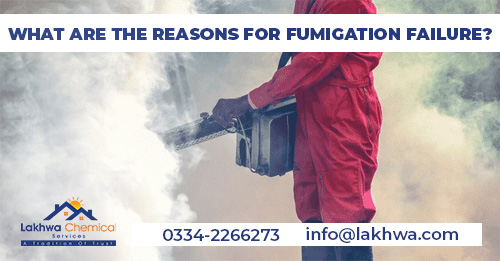WHAT ARE THE REASONS FOR FUMIGATION FAILURE?
According to the US Bureau of Labor Statistics (BLS), 20% of pest-control businesses under-perform during the initial two years and 65% in a decade! On a positive note, only 25% of businesses are capable of extending their journey ahead (15+ years). Under-achieving firms follow a dubious policy related to quality control, marketing, and management. Let’s discuss about reasons for fumigation failure!
Read More
List of Fumigation Services in Karachi
8 Types of Household Pests That Are Highly Dangerous
Why Termite Proofing is Important for Bungalows in Karachi?
Undefined Target Audience
Most of the pest control businesses are unclear of their target market and its specific needs. Without adequate knowledge, it is challenging to create an effective marketing strategy and connect with potential clients. ”Customers are the main-stay for service-line businesses; they represent the values and vision of the company in good stead. To ensure a large ROI (return on investment), firms need to manage their regular clients properly.” said by a renowned engineer cum businessman.
Inadequate Preparation
One of the most common reasons for fumigation failure is insufficient preparation. At times, workers may fail to identify potential areas, resulting in process inefficiency. Moreover, the harmful gas may escape from the area because of improper space coverage. Pre-fumigation cleaning can lead to residues or debris that interfere with the fumigant’s effectiveness. A lack of proper aeration can hinder the dissipation of residual fumigants, posing potential health risks to occupants.
Incorrect Fumigant Selection
Different pests require specific fumigants with distinctive characteristics: Using the wrong quality can affect the process negatively, resulting in incomplete pest elimination. Some insects may also develop resistance to certain fumigants over time. In that case, you need to consult experts and change the fumigant.
Improper Dosage and Application
The success of fumigation is based on the chemical dosage and the marked areas. Under-dosage may leave out some pests, while overdosage will lead to fumigant residues that surpass safe levels, posing risks to human health and the environment. Properly trained personnel are crucial for ensuring precise measurement and application of fumigants.
Temperature and Humidity Levels
Temperature and humidity play a crucial role in determining the efficacy of fumigation. Extreme temperatures, either too high or too low, can affect fumigant volatility and penetration, leading to reduced effectiveness. Likewise, high humidity can cause fumigants to bind with moisture, decreasing their concentration in the air and compromising their ability to reach target pests.
Read More
Salient Properties of Roof Insulation Material in Pakistan
Can Roof Insulation Material in Karachi Secure from Rain?
Can Roof Insulation Material in Karachi Fix Heatwaves?
Pest Life Cycle and Behavior
The quantity and behavior of pests also impacts the process of fumigation. Certain pests may enter a dormant phase, such as eggs or pupae, making them less susceptible to fumigant exposure. Others can develop an immune response against chemicals, compelling homeowners to change the quality of dosage.
Pest Resistance
As mentioned before, frequent or improper use of the same fumigant can lead to resistant pest populations. These insects will survive lethal fumigants without much hassles.
Inadequate Treatment Time
The contact time between the fumigant and pest is a critical factor for experts. It determines the success or failure of the job: Inadequate treatment time may not provide sufficient chemical exposure against pests, while proper timing can exterminate every insect in the structure. Factors, such as area coverage, fumigant concentration, and pest density should be considered for every task.
Structural and Sealing Issues
Structural problems in the treated area can result in poor fumigant distribution. Cracks, gaps, or leaks can allow fumigants to escape or create areas of lower concentration, leading to fumigation failure. Proper sealing of the space is essential to prevent fumigant leakage.
Conclusion
Fumigation failure is attributed to various factors, such as inadequate preparation and incorrect fumigant selection to improper dosage and application. Temperature, humidity levels, pest behavior, and resistance, and structural issues, can impact the success of fumigation. Overcoming these challenges require meticulous planning, proper selection of fumigants, and adherence to local laws and regulations.
To ensure a safe and effective pest control process, contact Lakhwa Chemical Services today. Their workers are professional and adept in dealing with different types of insects in homes and offices.


Leave a Reply
Want to join the discussion?Feel free to contribute!